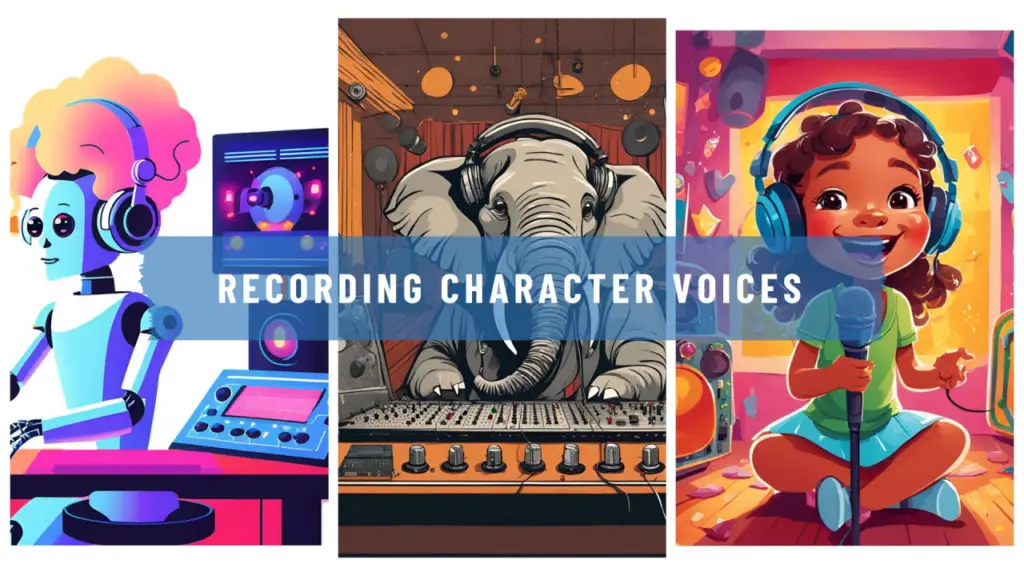Character voice acting is a fascinating and a great skill when it comes to animation, video games, and audiobooks. It’s an art that goes beyond reading lines; it’s about creating a unique persona with just your voice, making it believable and emotionally engaging. Whether you are bringing a beloved animated character to life, embodying a villain in a video game, or narrating a dramatic audiobook, the techniques of character voice acting are key to immersing the audience into a completely new world.
1. The Role of Emotion in Character Voice Acting
At the heart of great character voice acting is emotion. A character’s voice should reflect their personality, motivations, and inner world. The actor’s ability to convey these emotions through vocal tone, pitch, and pacing is crucial.
– Understanding the Character : Before jumping into the booth, a voice actor must fully understand the character. This involves studying the character’s backstory, goals, relationships, and flaws. The more you understand your character, the more real they will feel to the audience.
– Emotional Range : Great voice actors can express a wide range of emotions—happiness, fear, anger, excitement, sadness—using just their voice. Vocal techniques like altering pitch or pacing can be used to convey these emotions effectively. For instance, a higher pitch might convey excitement, while a slower pace with a deeper tone might suggest sadness or contemplation.
– Authenticity : The key to an authentic character voice is consistency. Whether the character is in a calm or high-stakes situation, the actor’s voice must stay true to the essence of that character. The best character voice actors make their performances feel natural, even if the character is extraordinary or fantastical.
2. Finding the Right Voice: Techniques for Creating Distinctive Characters
One of the challenges in character voice acting is creating a voice that stands out and feels distinctive, even if it’s an exaggerated or fantastical creation.
– Vocal Variety : Changing the pitch, speed, or texture of your voice can help craft unique characters. For example, a deep, gravelly voice can evoke strength or villainy, while a high-pitched, rapid-fire delivery can convey energy or anxiety.
– Character Archetypes and Tropes : Often, characters are based on familiar archetypes (the hero, the villain, the sidekick, etc.), but it’s the voice actor’s job to put their own unique twist on it. For instance, a “wise old sage” might have a slow, measured tone, but adding a quirky, unpredictable delivery can make it more memorable.
– Physicality and Movement : Though voice acting is done without a physical presence, how you move your body can influence the voice you create. Experimenting with different stances or gestures can help you find the right voice that fits the character’s personality and behavior. This method is often used by professionals to enhance the vocal delivery and make it more believable.
3. The Art of Impressions and Accents
Many character voice actors excel at impressions and accents, which can add depth and authenticity to their characters.
– Impressions : Recreating famous voices or celebrities can be part of voiceover work, especially in comedic roles. However, successful impressionists don’t just mimic sounds—they study the nuances, inflections, and emotional depth of the person’s speech patterns.
– Accents and Dialects : Playing characters with regional or international accents requires both vocal control and cultural sensitivity. It’s important to get the accent right without resorting to stereotypes, and to respect the authenticity of the character’s background.
4. Voice Acting in Different Mediums: Animation, Video Games, and Audiobooks
While the basic principles of character voice acting apply across mediums, each field has its own set of challenges and techniques.
– Animation : Animated characters often have exaggerated expressions and personalities, so the voice needs to match that energy. Animation voice actors may also need to sync their performance to the character’s movements, adding another layer of complexity. This requires a great deal of timing and precision.
– Video Games : Voice acting in video games involves a unique level of interaction, where characters may be responding to player actions or living in dynamic, non-linear worlds. The voice actor must remain consistent through various choices and outcomes, and their performance often includes a range of vocal reactions—combat shouts, battle cries, emotional moments, etc.
– Audiobooks : Audiobook narration requires voice actors to not only bring individual characters to life but also maintain a consistent voice throughout the entire story. The challenge here is to balance character distinction with narrative flow. The narrator must use subtle shifts in tone, pacing, and volume to keep listeners engaged over the course of several hours.
5. Final Thoughts: The Future of Character Voice Acting
As technology advances, voice actors are embracing new tools and techniques to push the boundaries of their craft. Artificial intelligence is becoming more prevalent in generating voices for digital avatars and characters, but there will always be a need for human actors (thank goodness!) to provide the emotional depth and nuance that machines cannot replicate. The future of character voice acting lies in versatility—being able to transition from animated characters to serious video game roles to narrating audiobooks with ease.
Whether you’re a seasoned pro or a newcomer, embracing the art of character voice acting means constantly experimenting with your vocal abilities, understanding the depth of your characters, and delivering performances that make the audience feel like they are truly living in the world you’ve created.
If you have any of your own tips on creating truthful character voices we would all love to hear them!
Now get back into your studio and record some voices of people, animals or characters you wouldn’t usually! And, of course, have fun!
Hannah

